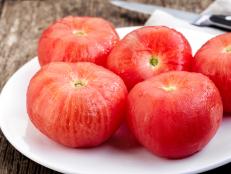What Is Blanching?
And a step-by-step guide on how to blanch fruits and veggies.

deepblue4you/Getty Images
By Alice K. Thompson for Food Network Kitchen
Alice is a contributing writer and editor at Food Network.
You’ve probably run across an instruction to blanch vegetables for a crudité platter or a composed salad, or maybe been told to do it before freezing a bounty of seasonal produce. But what exactly does it mean, and how do you do it? Read on for everything you need to know about this easy, versatile technique.
What Is Blanching?
Blanching is the process by which foods (usually fruits and vegetables) are briefly submerged in boiling water and then immediately cooled to stop further cooking. The technique deactivates enzymes that can affect the flavor, color and texture of produce, allowing it to be stored in peak condition. Blanched foods are cooked so briefly that they are still considered raw.
What Does Shocking Food Mean?
After food is blanched, quickly cooling it to stop the cooking process is known as “shocking” or “refreshing.” Drained food is plunged into a bowl of very cold water or ice water, or cooled under running water. Once thoroughly chilled, it's drained and gently dried to preserve its quality.
Why Blanch Fruits and Vegetables?
For home cooks, there are five main reasons to blanch foods:
- Set their color or to make colors more vivid
- Loosen skins for peeling
- Prepare foods for freezing
- Prepare foods for later cooking and shorten their cooking time
- Reduce pesticides and microbes on the surface of foods
Why Blanch Vegetables Before Freezing Them?
Blanching is necessary before freezing almost all vegetables to maintain their color, texture and flavor. Blanching stops the action of enzymes that can begin to break down produce, affecting its color, decreasing its nutritional content and shortening its storage time.
.jpg.rend.hgtvcom.616.411.suffix/1674765173229.jpeg)
Rene Wassenbergh / EyeEm/Getty Images
How Do You Blanch Vegetables?
Blanching is easy, and you can do a batch of most vegetables in about 15 minutes.
Step 1: Prep Your Vegetables
Rinse your vegetables and trim and slice them or separate them into florets as needed; many foods like green beans, asparagus spears, peas, okra and leafy greens can be left whole.
Step 2: Boil Water and Prepare an Ice Bath
Bring 1 gallon of water per pound of vegetables to a boil in a large pot. You can add a generous four-finger pinch of salt to the water if you like. Fill a large bowl or basin with very cold water or a combination of water and ice.
Step 3: Boil Your Vegetables
Add your vegetables to the water and cook until their color brightens and they barely soften. To blanch in batches, place the vegetables in a mesh basket and lower it into the water.
Blanching times vary depending on the type of vegetable and the size of your pieces, but the following are rough guidelines for some common vegetables. Note that blanching is always measured from the time the water comes back to a boil after the vegetables are added:
- asparagus: 2 to 4 minutes
- broccoli florets: 2 to 3 minutes
- carrot chunks: 2 to 3 minutes
- cauliflower florets: 2 to 3 minutes
- corn on the cob: 4 minutes
- green beans: 2 to 3 minutes
- okra: 3 to 4 minutes
- snap peas: 2 to 3 minutes
- snow peas: 2 minutes
- spinach leaves: 30 seconds
.jpg.rend.hgtvcom.616.411.suffix/1674765187060.jpeg)
Qwart/Getty Images
Step 4: Shock and Dry
As soon as your vegetables are done, scoop them out of the water and immediately plunge them into your bowl of ice water. Swish them around once, then leave them until they are completely chilled, a process that will take a few minutes. Drain the cooled vegetables and pat them dry.
How Do You Blanch Fruits?
Some fruits like peaches, apricots and tomatoes (yes, they’re botanically a fruit) are blanched to loosen their skins for easy peeling. To do this, cut a small “X” on the bottom of the fruit, lower it into boiling water with a slotted spoon or spider and let it boil until the skin is just barely softened, 30 to 60 seconds. Transfer the fruit with a spoon to a bowl of ice water until cooled, 1 to 2 minutes. It should now be easy to rub or use your fingers or a paring knife to pull the skin off in strips. If the skin sticks, repeat the blanching process.
Related Links:






















































